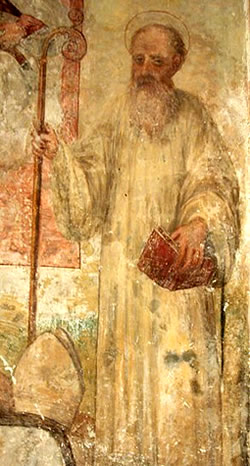 |
| Joachim of Flora |
Joachim was born at Celico in Calabria (southern Italy) around 1132. His father placed him at an early age in the service of the Sicilian court at Palermo. While on pilgrimage to the Holy Land, Joachim seems to have had an experience of spiritual illumination and conversion, after which he returned to Calabria and entered the Benedictine monastery of Corazzo around 1171.
In 1177 Joachim was elected abbot and, in his quest for the perfect realization of the monastic life, worked to incorporate Corazzo into the recently founded Cistercian order. Toward this end, around 1183 he traveled to the important monastery of Casamari south of Rome.
While there Joachim had mystical visions that illuminated his mind regarding the concordance of the Scriptures and the mystery of the Trinity. These visions not only launched Joachim’s writing career but also compelled him (dissatisfied with the Cistercian order of his day) to found his own religious house, the monastery of San Giovanni, at Fiore around 1190.
  |
In 1196 Joachim’s congregation became an officially recognized religious order, the Order of Fiore, which had a rather undistinguished history until it was reunited with the Cistercian order in 1570. Joachim himself died at San Giovanni on Holy Saturday in 1202 (March 30).
In his three major works, namely, The Book of Concordance of the Old and New Testament, Exposition of the Apocalypse, and The Psalter of Ten Strings, Joachim uses biblical prophecy to develop a trinitarian understanding of history that draws on, but diverges significantly from, the traditional Pauline and Augustinian scheme of “before the law,” “under the law,” and “under grace.”
Joachim finds the triune God in a more sophisticated system of three historically oriented “states of the world” (status seculi), each characterized by a manner of life, an order of the elect, and a certain part of sacred Scripture.
The first state, beginning with Adam and extending to Christ, is that of the Father. It is characterized by living according to the flesh, by the married order (established so that humans can become images of the Father by creating children), and by the Old Testament. The second state, spanning from Elisha the prophet to Joachim’s day, is that of the Son.
It is characterized by living between the two poles of flesh and spirit, by the order of clergy (who bear the image of the Son by preaching and teaching the Gospel), and by the New Testament. The third state, beginning with St. Benedict (c. 480–c. 550) and running to the consummation of the world, is that of the Spirit.
 |
| Fresco depicting Joachim of Flora |
Joachim understood himself and the spiritual men who constituted his Order of Fiore as those upon whom this spiritual understanding was being poured out as a sign of the coming end of history. It is in this concept of a third stage still to come that Joachim made his most original and lasting contribution to the theology of history generally and millenarianism in particular.
Although certain doctrines of Joachim were officially condemned at the Fourth Lateran Council (1215) and the Council of Arles (1263), his notion of a third state continued to influence visionaries and theorists of history during the late Middle Ages and beyond.